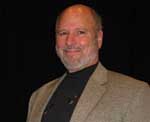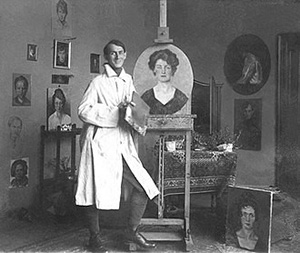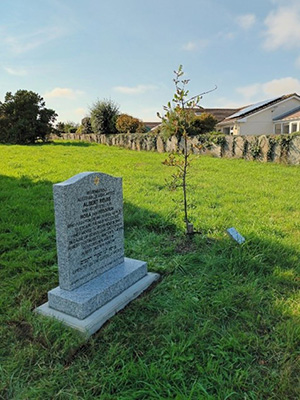

BOYNTON BEACH, Florida — Until I was contacted by Susan Soyinka, Albert Reuss’ biographer of his life in the U.K., Reuss was unknown to me. He was unknown to most people except for a limited group of art appreciators, and art historians. Soyinka did much to change that.
Albert Reuss was an Austrian Jewish painter who escaped the Holocaust by choosing refugee status in the United Kingdom in 1938.
Albert and his beloved wife Rosa left everything they had behind them in Austria, his paintings, his sculptures, his associations, his reputation, everything. They chose an unknown life over what would be for those Jews, who remained behind denying the reality of the Anschluss, an unimaginable tomorrow.
The Anschluss was the 1938 popular takeover of Austria by Nazi Germany.
As the Nazis marched into Austria to smiling faces, outstretched arms in the Heil Hitler salute, and flowers strewn about their feet, it was the arrival of death for Jews.
Reuss and his wife were among the lucky few who found bewildering refuge in England. This was the second time he had escaped his Jewishness.

In the 1920s, Albert and Rosa converted to Christianity. They were not religious people. Their conversion was a conversion of expediency. The post-World War I rising tide of hatred for the Jews closed door after door of opportunity to them in Austria. Increasingly, the Jews were accused of stabbing Austria in the back, being the cause of the loss of WWI.
Albert and Rosa were no more political than they were religious. His unique art style had found receptivity in Austria and was growing in Europe. They simply wanted to live quietly in the Vienna they loved and create art. They had no children. It was just the two of them, always together.
If becoming a Christian made their lives easier, it was a small price they were willing to pay.
Converting to Christianity was not the savior it had been for Jews, not wishing the choice of death, it had been for a millennium. The Nazis were not interested in Jewish souls. The Nazis did not believe Jews even had souls, no more than they believed dogs had souls.
A converted Jew, no matter how sincere their conversion, was still a Jew to them.
Twenty-five years before the Reusses converted to Christianity, another assimilated Austrian Jew was considering a similar decision for himself and his family. His name was Theodor Herzl.
Theodor Herzl, the formulator of political Zionism, is considered the Father of the modern State of Israel.
Keeping a Christmas tree in his home for the Holy Days, not following or knowing much about Judaism, refusing to circumcise his son Hans, did not garner Herzl acceptance in Austrian society. He remained a Jew in their eyes.
Herzl envisioned bringing all the Austrian Jews to St. Stephens in a mass conversion event that would end antisemitism once and for all. That never happened.
Hans saw his father’s life as a failure. There was no Jewish state. Jews were universally despised in Austria. Hans believed if he followed through with his father’s vision and became a Christian, at least his world would be one of acceptance as a human being.
Hans converted. In fact, he converted twice to two different Christian sects. In both cases, he learned the hard way that, as he wrote in his final letter before he committed suicide.
“My life is ruined… Nobody would regret it if I were to put a bullet through my head. Could I undo my errors that way? I realize how right my father had been when he once said: “Only the withered branches fall off a tree – the healthy ones flourish.” A Jew remains a Jew, no matter how eagerly he may submit himself to the disciplines of his new religion, how humbly he may place the redeeming cross upon his shoulders for the sake of his former coreligionists, to save them from eternal damnation: a Jew remains a Jew….I can’t go on living.”
Hans put a bullet through his head. His remains were finally returned for burial in Israel in 2006.
Albert and Rosa Reuss reconstituted their lives as best they could in England’s Cornwall. They settled near Mousehole, where Albert painted and Rosa supported him in every way possible. Their families had been exterminated in the Holocaust. There was nothing to go back to.
Albert’s painting changed dramatically after he became a refugee in England. He and his work became dark. He never overcame the trauma of the “Churban,” the Holocaust.
If not for their love for each other in the Sea of Darkness, they would have perished into forgottenness. Albert painted until his end.
His beloved Rosa died in 1970. Albert lived on for another five years, recluse, isolated.
They had found life’s shelter in the small town near Penzance, but they never found life again. They remained refugees.
Rosa was cremated, her ashes scattered into the sea. Albert too was cremated. His ashes scattered into the sea. They existed no more except for the art they left behind.
Susan Soyinka had been referred to me on the off chance I would be willing to fund a Remembering Stone for Albert and Rosa.
I was.
I explained to her:
“I see them as representative allegories of the trauma of the refugee experience. Though a Reuss Remembering Stone is focused on the Jewish story, the need is to understand what is happening to millions in times of war. The uprooting, the intolerance, the hate, anger, and desperation should never be forgotten or misunderstood.”
Susan steered the effort for the stone. She recommended a very appropriate setting in the 12th century English Churchyard of St. Pol-de-Leon Church, Paul Parish, Penzance.
The Remembering Stone is placed adjacent to a Tree of Memory planted by the Association of Jewish Refugees, U.K. The Association had planted the tree in January in honored memory, in gratitude, to the people of Cornwall who took in over 100 Jewish refugee children eighty years ago.
The Text of the Stone:
Remembering Austrian
Jewish Artist
Albert Reuss
and his devoted wife
Rosa nee Feinstein
who fled Vienna to England in 1938
to escape the Nazi Holocaust.
They moved to Mousehole in 1948.
Because of Rosa’s love and support
Albert continued to paint until the end.
Rosa died in 1970 aged 78
Albert died in 1975 aged 86
פותח לנו שערי רחמים
Open to us the Gates of Mercy
Jewish American Society for Historic Preservation
*
Jerry Klinger is the president of the Jewish American Society for Historic Preservation
www.JASHP.org